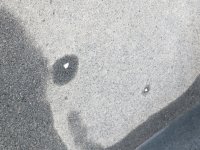- Nov 10, 2024
- 5
- Pool Size
- 18000
- Surface
- Plaster
- Chlorine
- Salt Water Generator
- SWG Type
- Pentair Intellichlor IC-40
My pool is 4 years old, 18k gal, salt, gunite in KY. I am (hopefully) learning to manage it. There are a number of small white mineral (I presume calcium) deposits. These are mostly around 1/8 to 1/4 inch; some are thin (maybe 1/16 inch) and longer up to 2 inches. Some of these are in small imperfections in the plaster surface. The surface in general is mildly rough (sandpaper like) and not as smooth as 4 years ago. Is all this due to scale? Recent numbers: Chl 3.0, pH 7.7, TA 95, CYA 36, CSI (-0.28), Chl/CYA 0.083, CH 251, Salt 4100, Phos 4000, Water temp 58. I was not aware of the significance of the saturation index until recently so I’m paying attention to CSI now. Any specific ideas of products or other advice that will help with the scaling? I appreciate any and all advice! Thank you.





